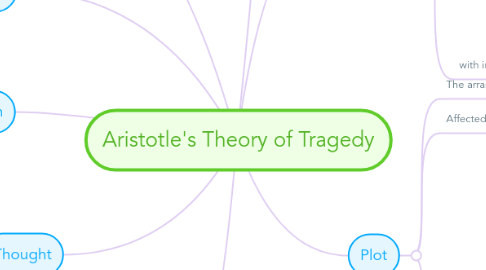Aristotle's Theory of Tragedy
作者:Ian Lo


1. Thought
1.1. Where something is proved to be or not to be, or a general maxim is enunciated
1.2. may call as themes of a play
2. Characters
2.1. Good or Fine
2.2. Fitness of character
2.3. True to life
2.4. Consistency
2.5. Necessary or Probable
2.6. True to life and yet more beautiful
3. Diction
3.1. The expression of the meaning in words
3.1.1. Plot
3.1.2. Characters
3.1.3. End of the tragedy
4. Melody
4.1. Fully integrated into the play like an actor
5. Spectacle
5.1. The production of spectacular effects
5.2. Pity and Fear
6. The End Of Tragedy: Katharsis
6.1. Purging
6.2. Arouses of pity and fear
7. Definition
7.1. form of action
7.2. Shows rather than tells
7.3. 6 parts
7.3.1. Plot
7.3.2. Characters
7.3.3. Thought
7.3.4. Diction
7.3.5. Melody
7.3.6. Spectacle
7.4. with incidents arousing pity and fear
8. Plot
8.1. The arrangement of the incidents
8.2. Affected by cause-and-effect
8.3. Qualities
8.3.1. 1. A whole
8.3.1.1. Beginning
8.3.1.2. Middle
8.3.1.3. The end
8.3.2. 2. Complete
8.3.2.1. Structurally self-contained
8.3.3. 3. of a certain magnitude
8.3.3.1. Quatitatively
8.3.3.2. Qualitatively
8.3.4. 4. Simple or Complex
8.3.4.1. Simple
8.3.4.1.1. Change of Fortune
8.3.4.2. Complex
8.3.4.2.1. Reversal of intention (Peripeteia)
8.3.4.2.2. Recognition (Anagnorisis)
